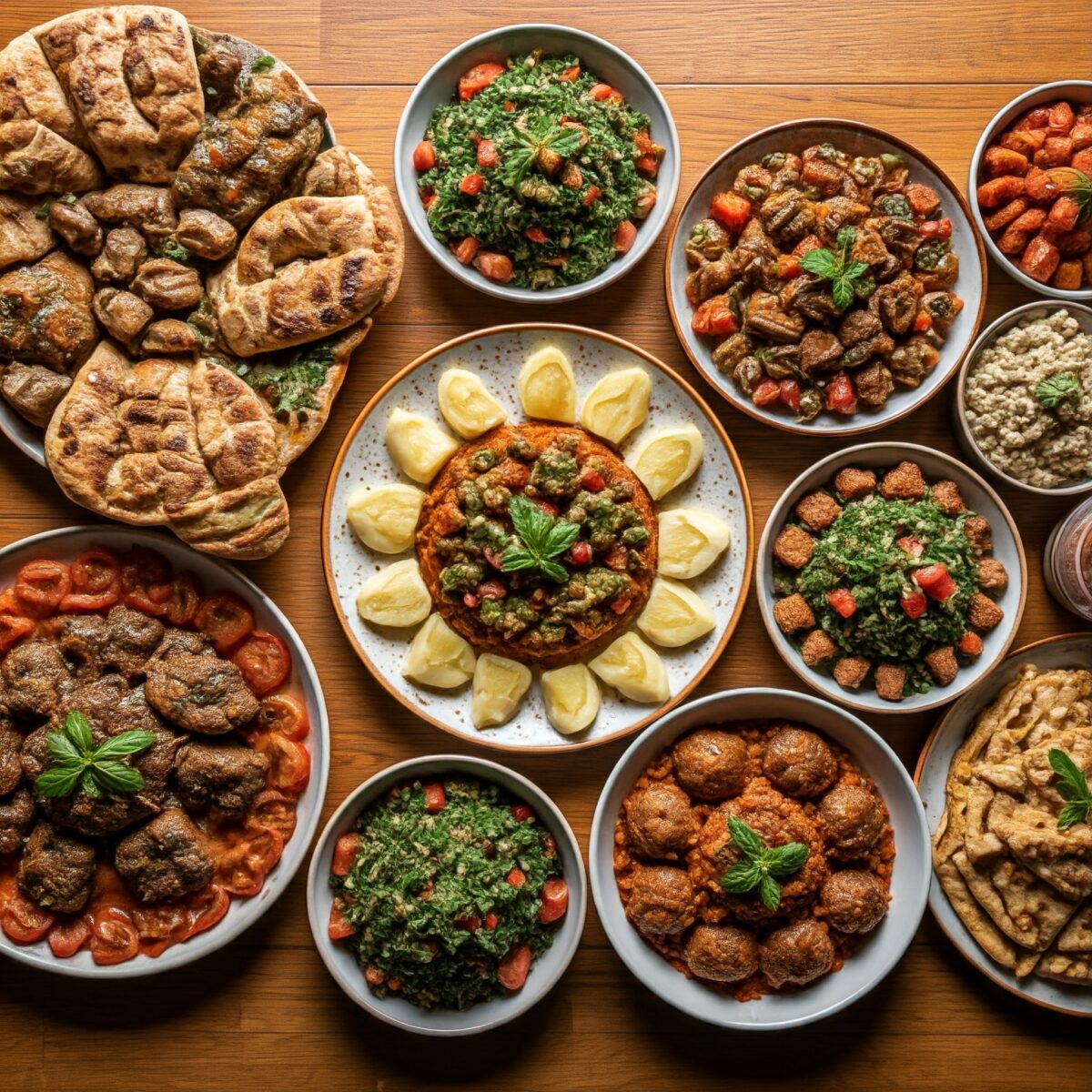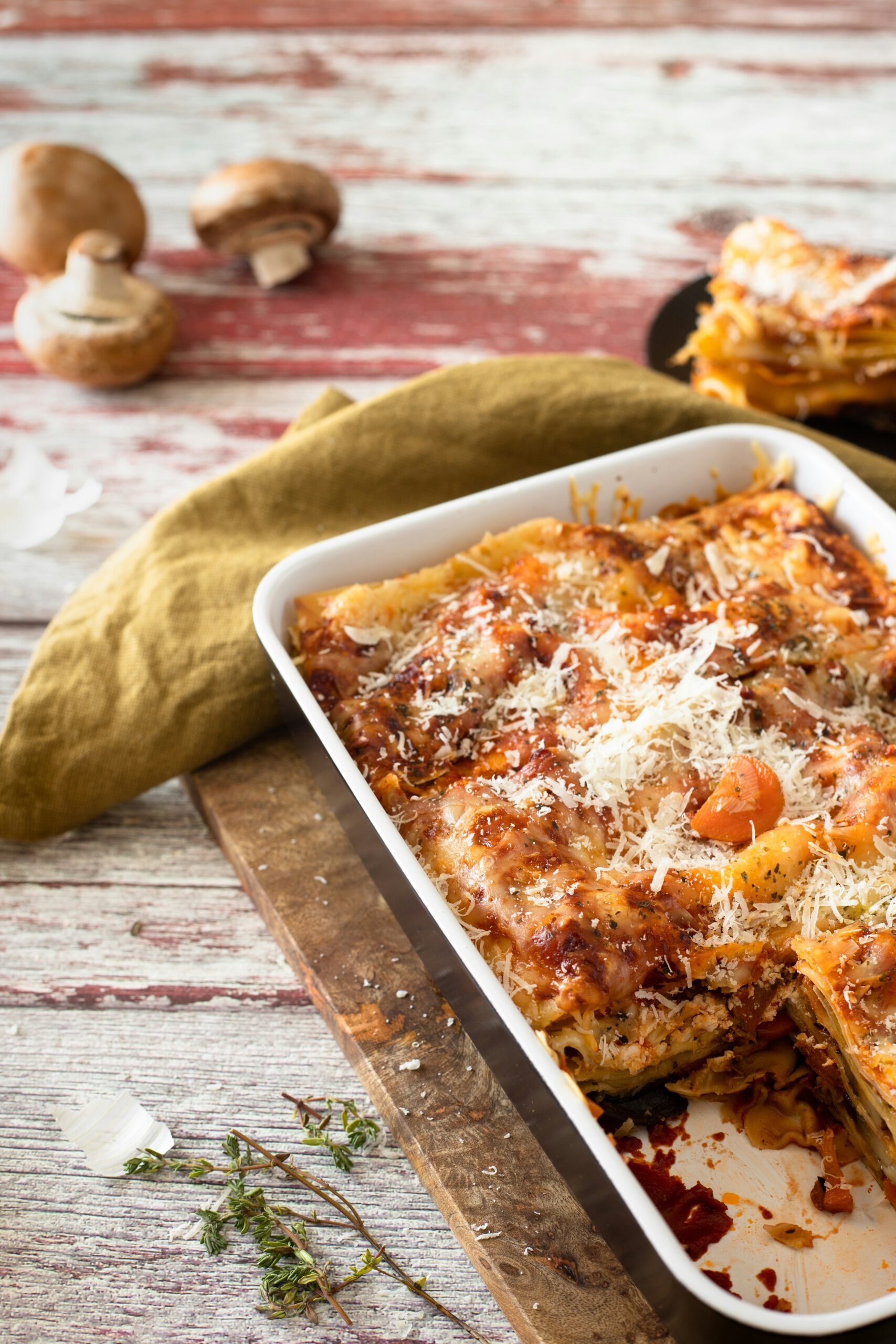Introduction to Lebanese Cuisine
Lebanese cuisine is renowned for its vibrant flavors and rich history, making it a captivating aspect of Middle Eastern gastronomy. This culinary art form has evolved over centuries, influenced by various cultures and a diverse geographical landscape. The foundation of Lebanese cooking is rooted in the Mediterranean tradition, which emphasizes the use of fresh vegetables, fruits, grains, and legumes, creating a colorful tapestry of flavors and textures.
At the heart of Lebanese cuisine lies an array of herbs and spices that play a pivotal role in defining its distinctive taste. The use of ingredients such as sumac, za’atar, and cinnamon not only enhances the flavor profile but also celebrates the culinary heritage of the region. Herbs like parsley, mint, and cilantro are staples in many Lebanese dishes, adding freshness and depth to the meals. The expert combination of these elements results in a cuisine that is both satisfying and intriguing, inviting diners to savor a multitude of tastes in every dish.
In addition to its flavor diversity, Lebanese cooking is characterized by its communal aspect. Meals are often served mezze-style, allowing for a shared dining experience that fosters connection and camaraderie. This style showcases a multitude of small dishes, from the beloved hummus and baba ghanoush to vibrant tabbouleh and falafel. Each dish tells a story, reflecting the region’s agricultural bounty and the culinary skills passed down through generations. Thus, the charm of Lebanese cuisine lies not only in its rich recipes but also in the cultural traditions that surround them, making it a true representation of Lebanon’s identity.
Exploring the Flavors of Lebanon
Lebanese cuisine is renowned for its intricate flavors and diverse culinary palette, which reflect the country’s rich cultural heritage and geographical diversity. The distinct taste of Lebanese dishes is primarily defined by a harmonious blend of fresh ingredients, vibrant herbs, and aromatic spices. These elements intertwine to create a taste profile that engages the senses, providing a gastronomic experience that is both satisfying and memorable.
At the heart of Lebanese cooking is the use of herbs and spices, which form the backbone of many traditional dishes. Common ingredients such as thyme, mint, and parsley add freshness, while spices like cinnamon, allspice, and sumac introduce warmth and complexity. This balance is often exemplified in popular Lebanese dishes such as tabbouleh and kibbeh, where the interplay of herbs and spices not only enhances flavor but also provides a visual feast. The reliance on seasonal vegetables and high-quality ingredients further ensures that each dish celebrates the natural bounty of Lebanon’s diverse landscape.
The geographical location of Lebanon plays a crucial role in shaping its culinary identity. The fusion of Mediterranean and Middle Eastern influences results in a unique flavor profile that distinguishes Lebanese cuisine from its neighbors. From the coastal areas boasting fresh seafood to the mountainous regions producing hearty grains and legumes, the variety of ingredients available ensures that Lebanese cooking remains vibrant and versatile. Additionally, the art of meze, a collection of small plates served in social settings, allows diners to experience an array of flavors and textures in one meal, promoting the idea of sharing in Lebanese culture.
In conclusion, the flavors of Lebanese cuisine are a testament to its rich history and cultural diversity. The careful balance of herbs, spices, and fresh ingredients fosters a culinary experience that resonates with both locals and visitors, embodying Lebanon’s vibrant heritage through each dish.

The Role of Food in Lebanese Culture
In Lebanese culture, food transcends mere sustenance; it acts as a conduit for social interaction, community bonding, and the passing of traditions. Lebanese cuisine is deeply intertwined with the identity of the people, as it encapsulates a rich history of flavors and ingredients that speak volumes about the cultural heritage of Lebanon. The use of diverse herbs and spices contributes to the distinctiveness of Lebanese cooking, establishing a vibrant culinary scene that fosters both familial and social connections.
Gatherings in Lebanese culture often revolve around food, where meals become a celebratory event that strengthens familial ties and friendships. Whether it is a festive holiday, a wedding, or a casual get-together, the cuisine plays a pivotal role in these gatherings, allowing individuals to share stories, laughter, and mutual appreciation. The act of preparing meals together not only reinforces connections but also creates an opportunity to pass down culinary traditions and recipes from one generation to the next. This practice enhances the communal and familial atmosphere through the shared experiences tied to cooking and dining.
Moreover, Lebanese cuisine serves as a reflection of the country’s social fabric. It encapsulates the legacy of its history, showcasing influences from various cultures and regions that have mingled over centuries. The nuances in flavors, from the zest of a spice blend to the fresh vibrancy of herbs, all signify the uniqueness of Lebanese identity. Consequently, enjoying a meal together becomes a celebration of shared culture, where each dish has its own story, thus creating a sense of belonging and unity among diners. As such, food in Lebanese culture is much more than nourishment; it is an essential component of community and identity, steeped in tradition and collective memory.
The History and Cultural Significance of Lebanese Cuisine
Lebanese cuisine, deeply rooted in the rich history of Lebanon, reflects the influence of various cultures and civilizations that have populated the region throughout the centuries. The country’s geographic position at the crossroads of the Mediterranean, Asia, and Europe has made it a melting pot of culinary traditions. This unique backdrop has significantly influenced the evolution of Lebanese cooking, marrying local ingredients with diverse flavors.
The culinary landscape began to take shape during ancient times, with the Phoenicians playing a pivotal role in establishing trade routes that promoted the exchange of herbs and spices. Such interactions allowed for the introduction of distinct cooking methods and flavors, demonstrating that Lebanese cuisine is inherently a product of historical migrations and trade. Ottoman influences also left a lasting impact, incorporating various cooking styles and dishes that enriched the local palate, further culminating in the vibrant tapestry of flavors and techniques seen today.
Throughout history, the resilience of the Lebanese people in the face of political and social upheaval has also shaped their gastronomy. Simple, yet flavorful dishes often emerged from necessity, using readily available local ingredients and traditional methods. This practicality is evident in staples such as hummus and tabbouleh, which hold significant cultural importance and showcase the enduring spirit of Lebanese cooking.
Moreover, Lebanese cuisine is not just about nourishment; it embodies social connections and cultural identity. Meals often bring people together, strengthening familial and communal bonds. Traditional feasts and celebrations prominently feature dishes that symbolize hospitality and share the joy of life, emphasizing the importance of Lebanese culinary practices.
As Lebanon continues to evolve, its cuisine remains a vital reflection of its history, demonstrating how past events and cultural exchanges have led to a lively and diverse culinary heritage that endures to this day.
Origins of Lebanese Culinary Traditions
The rich tapestry of Lebanese cuisine is deeply rooted in the country’s historical and geographical context. Situated at the crossroads of the Mediterranean and the Arabian Peninsula, Lebanon has been influenced by various civilizations over the centuries, including the Phoenicians, Romans, Ottomans, and French. Each of these cultures contributed unique ingredients, techniques, and culinary practices, resulting in a diverse and vibrant food culture that is celebrated today.
Ancient Lebanese cooking was characterized by the use of local ingredients and natural resources. Abundant herbs and spices, such as za’atar, sumac, and allspice, have been staples in Lebanese cooking for millennia. These flavorings not only enhanced the taste of dishes but also reflect the agricultural richness of the region. The method of preparing and preserving food has also evolved, with techniques such as pickling and fermenting still evident in contemporary recipes. This preservation of ancient culinary methods is a testament to the resilience of Lebanese culture.
The transition through various empires and movements has left an indelible mark on Lebanese culinary traditions. The Ottoman influence, for example, introduced a variety of dishes that incorporated sumptuous spices and elaborate preparations, while the French mandate in the early 20th century introduced new techniques and ingredients that enriched the local food culture. As a reflection of this, modern Lebanese cuisine maintains a balance between tradition and innovation, with chefs often experimenting while staying true to their roots.
Today, Lebanese cooking remains a vital expression of the nation’s identity, showcasing its historical influences while emphasizing the fresh herbs and spices that continue to define its culinary landscape. The enduring legacy of Lebanese cuisine is celebrated not only within the country but also among food enthusiasts around the world, making it an integral part of the global gourmet experience.

Key Ingredients in Authentic Lebanese Cooking
Authentic Lebanese cuisine is celebrated for its vibrant flavors, which are achieved through the expert use of various key ingredients. Central to this rich culinary tradition are an array of herbs and spices that enhance the taste of each dish. Prominent among them are za’atar, a blend typically made with thyme, sumac, and sesame seeds, which adds a zesty and earthy flavor to grilled meats and flatbreads. Another essential spice is cinnamon, commonly used in savory dishes and desserts alike, imparting warmth and depth to recipes.
The use of fresh herbs also plays a critical role in Lebanese cooking. Parsley is perhaps the most ubiquitous, often found in dishes ranging from tabbouleh to various stews. Mint, another staple, offers a refreshing contrast in salads and is also steeped in traditional drinks, further showcasing the balance of flavors in this cuisine. Additionally, the use of garlic and lemon is prevalent, providing brightness and acidity that elevate many Lebanese meals.
In addition to herbs and spices, staple grains such as bulgur wheat and rice are foundational in Lebanese food preparation. Bulgur is commonly used in salads and as a base for a variety of meat dishes, while rice often appears as a side, typically prepared with spices or as part of a pilaf. Fresh vegetables, including eggplant, tomatoes, and bell peppers, not only add color to the table but also nutritional value, serving as key components in dishes like mujaddara and stuffed vegetables.
Thus, the essence of Lebanese cuisine lies in its key ingredients—each contributing to its unique flavor profile and cultural significance. Understanding these components is vital for anyone looking to explore the delights of authentic Lebanese cooking.
Popular Lebanese Dishes and Recipes
Lebanese cuisine is a treasure trove of flavors, marked by its extensive use of herbs and spices that contribute to its rich culinary heritage. One of the most cherished aspects of this vibrant cuisine is the mezze, a selection of small plates served during gatherings. Notable mezze items include hummus, a creamy blend of chickpeas, tahini, and garlic, and tabbouleh, a refreshing salad made with parsley, mint, tomatoes, and bulgur. These dishes embody the use of fresh ingredients, allowing the natural flavors to shine through.
Another popular dish is baba ghanoush, a smoky eggplant dip that combines roasted eggplant with tahini, lemon juice, and garlic, creating a delightful spread for bread or vegetables. Each of these mezze not only highlights the versatility of Lebanese cooking but also invites communal enjoyment, making them ideal for sharing among family and friends.
Moving to signature main courses, one cannot overlook the iconic kebabs. Various types of kebabs feature minced or marinated meat seasoned with aromatic spices and grilled to perfection. The use of spices such as cumin, coriander, and allspice in Lebanese cooking elevates these dishes to new heights, ensuring a complex flavor profile that satisfies diverse palates. Laban, a yogurt-based sauce, often accompanies kebabs, adding a tangy component to the meal.
Another staple is the famous Lebanese dish, mujadara, which consists of lentils, rice, and caramelized onions. This wholesome dish reflects the simplicity yet richness of Lebanese cuisine, resonating with both health and flavor. Each recipe captures the essence of traditional Lebanese cooking, providing a glimpse into the historical roots and cultural significance of these dishes.
Overall, the array of Lebanese dishes exemplifies the culinary diversity and invites individuals to explore the delightful flavors and techniques embedded in Lebanese cuisine. Embracing these recipes offers an opportunity to experience a part of the Middle Eastern gastronomic tradition.
Traditional Cooking Techniques in Lebanese Cuisine
Lebanese cuisine is a delightful tapestry of flavors and textures intricately woven through traditional cooking techniques. These methods not only preserve the essence of the ingredients used but also enhance the overall sensory experience of the dishes. Among the most prominent techniques in Lebanese cooking is grilling, which is celebrated for imparting a smoky flavor to meats and vegetables. Charcoal grilling, or “mashwi,” is common in preparing staples like kebabs and shish tawook, ensuring a perfect balance of tenderness and char.
Another essential technique is roasting, often utilized to bring out the natural sweetness of vegetables and the rich flavors of meats. Roasted dishes, such as “roasted za’atar chicken,” benefit from the aromatic combination of herbs and spices, showcasing the culinary versatility inherent in Lebanese cuisine. The slow cooking method, frequently employed in stews and casseroles, allows flavors to meld beautifully over time. Dishes like “kousa mahshi” (stuffed zucchini) or “loubieh bil zeit” (green beans in tomato sauce) exemplify how slow cooking can create a comforting and satisfying meal.
Stewing is yet another technique deeply rooted in Lebanese culinary practices. This method involves simmering ingredients in a combination of broth, spices, and sometimes tomatoes, allowing the food to absorb the robust flavors around it. Traditional stews can take several hours to prepare, but the end result is always worth the wait, reflecting the care and love behind Lebanese cooking. Herbs and spices play a vital role in these techniques, bringing the dishes to life with their aromatic and flavorful profiles. The expert use of these methods is key to creating the rich, savory flavors that define authentic Lebanese cuisine.
Health Benefits of Lebanese Cuisine
The comprehensive approach to meal preparation in Lebanese cuisine includes a variety of fresh ingredients, herbs, and spices that not only enhance flavor but also provide numerous health benefits. Traditionally, Lebanese cooking emphasizes the use of whole, unprocessed foods such as fresh vegetables, legumes, grains, and healthy fats like olive oil. This focus on natural ingredients contributes to a balanced diet that is rich in nutrients, making it a desirable choice for those looking to maintain a healthy lifestyle.
One of the standout aspects of Lebanese cooking is the inclusion of herbs and spices like parsley, mint, garlic, and sumac. These components are not merely for flavor; they offer significant health benefits. For instance, garlic is known for its antibacterial and antiviral properties, while parsley is packed with vitamins A, C, and K. The use of spices provides additional advantages, as many possess anti-inflammatory properties and can help in digestion. Furthermore, a well-balanced meal often includes a variety of components, such as salads, grilled meats, and lentils, ensuring a diverse intake of vitamins and minerals.
Beyond the nutritional properties of the food itself, the communal nature of dining in a Lebanese context enhances overall well-being. Meals are often shared among family and friends, fostering social connections that contribute to mental and emotional health. This aspect of Lebanese cuisine encourages mindful eating practices, where individuals take time to enjoy each bite rather than consuming meals hastily. The culture surrounding Lebanese cooking promotes an appreciation for food and its origins, ensuring that dining is not only a necessity but also a joyful experience.
In conclusion, the health benefits associated with Lebanese cuisine extend beyond nutrient density; they encompass a holistic approach to wellness that integrates fresh ingredients, mindful eating, and social connection, making it a commendable choice for health-conscious individuals.
Tips for Cooking Authentic Lebanese Dishes at Home
To successfully recreate authentic Lebanese cuisine in your own kitchen, a few practical tips can significantly enhance your culinary experience. First, focus on sourcing high-quality ingredients, particularly fresh herbs and spices that are foundational to Lebanese cooking. Ingredients such as sumac, za’atar, and allspice are essential for achieving the vibrant flavors synonymous with Lebanese dishes. These can often be found in specialty grocery stores or online, where you may also discover unique blends that cater specifically to Lebanese recipes.
Understanding the role of herbs and spices is crucial. For instance, fresh parsley and mint lend freshness to salads like tabbouleh, while warm spices such as cinnamon and nutmeg impart depth to savory dishes like stews. Experimenting with the right combination of these elements can help you replicate the rich, complex flavors of authentic Lebanese cuisine. Moreover, marinating meats with combinations of garlic, lemon, and olive oil not only infuses flavors but also tenderizes the meat, further enhancing the final dish.
In addition to sourcing the right ingredients, having the correct kitchen tools can streamline your Lebanese cooking experience. Investing in a high-quality knife ensures that your chopping is efficient, while a mortar and pestle can be invaluable for grinding spices fresh for each meal. A food processor can also be beneficial, particularly for preparing dips like hummus or baba ghanoush, which require a smooth texture. Moreover, using clay or earthenware cookware—traditional in many Lebanese households—can elevate the authenticity of your cooking process.
In conclusion, by paying attention to ingredient quality, understanding the use of herbs and spices, and utilizing the right kitchen tools, you can create authentic Lebanese dishes that will transport you to Lebanon with every bite.




Pingback: Fattouche Salad Recipe: Fresh, Flavorful, and Easy to Make